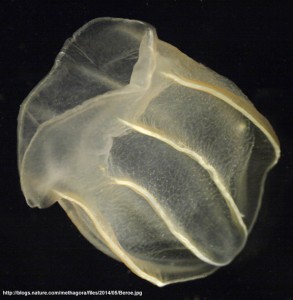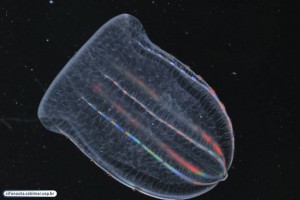Marine Organism of the Week
Beroe ovata – Phylum Ctenophora (comb jellies)
Posted by Josh Lord
 Beroe ovata – carnivorous ctenophore (Source: http://blogs.nature.com/methagora/files/2014/o5/Beroe.jpg)
|
Ctenophores, or comb jellies, are named for the groups of cilia called ctenes that they use to propel themselves through the ocean. Most ctenophores feed by capturing tiny zooplankton and phytoplankton with sticky cells called colloblasts that produce adhesive on the ctenophores tentacles. However, the ctenophore Beroe ovata feeds on much larger prey: other ctenophores! They have no colloblasts or tentacles, and instead have a very large mouth opening, allowing them to swallow other ctenophores whole. Because their bodies are flexible, Beroe can even swallow other ctenophores that are larger than they are.
Youtube video of Beroe ovata feeding: https://www.youtube.com/watch?v=1xkNPp6mzzI
In the Caspian Sea, another ctenophore species (Mnemiopsis leidyi) has become so abundant that it is causing reductions in fish stocks by outcompeting fish for food (zooplankton). Because Beroe eats Mnemiopsis, the recent unintentional introduction of Beroe in the Black Sea did cause a dramatic drop in the number of Mnemiopsis. Therefore, scientists are considering intentionally introducing Beroe to bring down the Mnemiopsis populations in the Caspian Sea.
